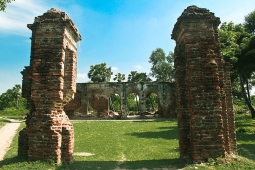Did You Know? The Cosmopolitan city of Chang’an at the Eastern End of the Silk Roads
© Mark FischerThe termini, or start and end points, of the various routes which made up the Silk Roads were often sites of intense interactions and exchanges resulting in the formation of large cosmopolitan cities centred around this mercantile activity. One such eastern terminus of the Silk Roads was the city of Chang’an located close to the modern day city Xian in Shaanxi Province, China. During the Tang dynasty (618 -907 CE) in particular, a surprisingly diverse group of people made this major trade hub their home including many from Sogdiana the Iranian civilization formed of a collection of city states located at various times in what is today Uzbekistan, Tajikistan, Kazakhstan, and Kyrgyzstan, and whose capitals included the famous Silk Roads cities of Samarkand and Bukhara.
Chang’an served as the capital city of ten different dynasties, three of the most significant and long lasting of which were the Former Han (206 BCE – 9 CE), the Sui (589-617 CE) and the Tang (618 – 907 CE). In 582 CE, during the Sui dynasty the capital was relocated to Chang’an where a new layout for the city was carefully planned and built. During this time, the city had 109 districts or quarters called ‘fang’ each with a wall around it. In addition to fulfilling an important function as a seat of political power, the city was also a terminus of the Silk Roads, acting as a starting and ending point for people and goods moving along it. In particular Chang’an was a starting point for overland travel from China to the Indian Subcontinent, the Arabian Peninsula, Iranian Plateau, and onwards to the East African coast. Indeed, during the peak of Silk Roads activity throughout the first millennium Chang’an welcomed visitors travelling from both overland and sea routes for a variety of reasons, some of whom stayed and made the city their home. It is believed that during its 8th century CE peak the city (including its suburbs) was home to as many as 3 million inhabitants from across China as well as other regions along the Silk Roads, making it one of the largest concentrated populations of the time.
The Sogdians were renowned merchants who established a trade network all the way from their home in Central Asia to China. The discovery of a number of Sogdian tombs in the city has provided considerable insight into the ways in which elements of Sogdian culture infused into the Chinese society of Chang’an and vice versa. The tombs of two different Sogdian sabao, a foreign official formally appointed to administer for that community, were discovered in Xian in the early 21st century. Both of these tombs combine Chinese and Sogdian motifs and mix two different tomb styles with epitaphs written in both Sogdian and Chinese. One tomb featured a painting above the entrance door of a Zoroastrian fire altar on a table carried by two camels. In addition, there are panels depicting scenes of people dancing the ‘Sogdian swirl’ a popular dance performed at parties introduced to the region. Camels carrying goods are carved on a number of interior panels of these tombs but seemingly within a diplomatic context of gift giving. In this respect, these images resemble those surviving on the Sogdian Afrasiab palace murals in Samarkand in that they reflect the envoy-dominated trade taking place across the Silk Roads at the time.
Furthermore, with its tree lined avenues, walled districts, parks, and areas dedicated to specific functions such as religion, commerce, and manufacturing, the layout of Chang’an provided a model for city construction which was later adopted in other regions along the Silk Roads, notably in the Korean Peninsula and Japan. In addition to Buddhist, Manichaean, and Zoroastrian temples, within the city layout were two walled market districts, the Eastern and Western Markets. The Eastern market was home to domestic goods whilst the Western Market, which was home to Chang’an’s sizeable foreign community, sold goods exchanged and imported via the Silk Roads most of which were delivered by camel trains. These markets had food and drink shops, as well as warehouses where travelling merchants could store their wares, deposit money, and stay for some periods of time. These foreign communities brought with them many concrete elements, including those associated with religion, and this is reflected in the at least five, maybe six, Zoroastrian and Manichean temples which were located around the Western Market. However, today in Xian only two Tang dynasty structures which reflect the Silk Roads exchanges which took place in the city remain standing, the Big Goose Pagoda, and the Small Goose Pagoda. Notably, the Big Goose Pagoda was built to house the books which the Chinese Buddhist monk, traveller, scholar, and translator, Xuanzang bought home from travels across the Indian Subcontinent.
Cities such as Chang’an grew up along the Silk Roads thanks to their strategic locations. They provided the ports and markets which punctuated the trade routes and provided places where after weeks of travelling merchants could rest, sell, or buy goods, but also converse with new people and exchange ideas, customs, and languages. Because of this, cities such as Chang’an attracted scholars, teachers, theologians, and philosophers, becoming great centres for intellectual and cultural exchange, and forming the basis for the development of many civilizations throughout history.








